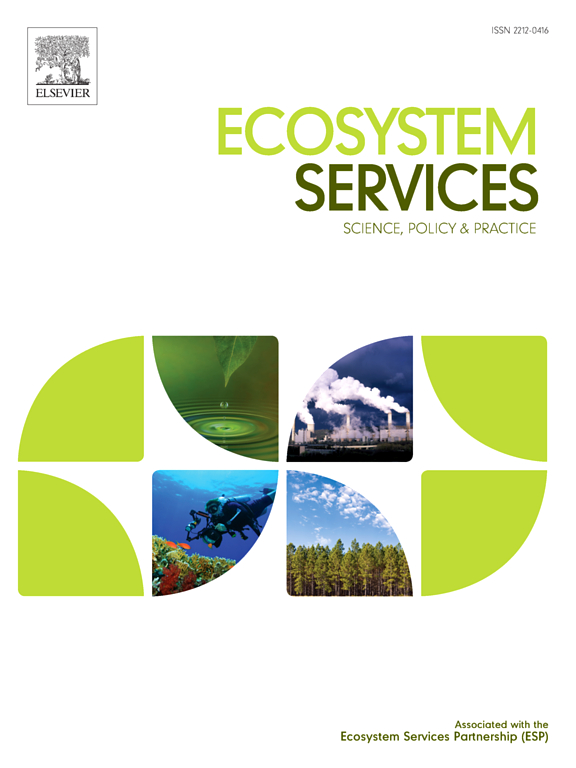保护区的文化生态系统服务和非服务:基于游客数字足迹的热点和影响因素
IF 6.6
2区 环境科学与生态学
Q1 ECOLOGY
引用次数: 0
摘要
保护区提供了宝贵的文化生态系统服务,受到越来越多的关注。然而,文化生态系统服务(CES)的标准化评估标准仍然缺乏,影响因素也大多未知,因此很难全面了解保护区的文化生态系统服务。针对这些局限性,我们建立了一个全面的文化生态系统服务评估框架,并选择武夷山国家公园作为案例研究对象,该公园是著名的世界遗产,吸引了大量游客。我们采用基础方法从游客的数字足迹数据(N = 13738)中分析了CES的构成,并使用核密度估计(KDE)和Geodetector分析了CES的空间分布和影响因素。结果显示,在数字足迹数据编码得出的所有十类 CES 中,娱乐休闲所占比例最高(47.63%),而四类文化生态系统服务(CEDS)占数字足迹编码计数的 13.15%。已确定的 CES 热点呈现出东部数值较高而西部较低的模式。这种模式主要受社会经济因素的影响,如国内生产总值(q = 0.477)、地区娱乐受欢迎程度(q = 0.380)和人口密度(q = 0.363)。GDP 与距离城镇中心的距离之间的交互作用有很大的影响(q = 0.641)。本研究拓展了定量评估保护区 CES 的方法,揭示了 CES 与 CEDS 的空间差异,为实现保护区的有效保护和可持续管理提供了科学、有据可依的参考。本文章由计算机程序翻译,如有差异,请以英文原文为准。
Cultural ecosystem services and disservices in protected areas: Hotspots and influencing factors based on tourists’ digital footprints
Protected areas provide invaluable cultural ecosystem services, attracting increased attention. However, standardized evaluation criteria for cultural ecosystem services (CES) are still lacking, and the influencing factors remain largely unknown, making it difficult to fully understand the CES of protected areas. To address these limitations, we established a comprehensive framework for assessing the CES and selected Wuyishan National Park as a case study, a famous world heritage site attracting large numbers of visitors. A grounded approach was employed to analyze the composition of CES from visitors’ digital footprints data (N = 13,738), and kernel density estimation (KDE) and Geodetector were used to analyze spatial distribution and influencing factors. Results showed that recreation and leisure accounted for the highest proportion (47.63 %) of all the ten CES types derived from the coding of digital footprint data, while four categories of cultural ecosystem disservices (CEDS) constituted 13.15 % of the digital footprint coding count. Hot spots of CES were identified, which exhibited a pattern of higher values in the east and lower in the west. This pattern was primarily influenced by socio-economic factors such as GDP (q = 0.477), regional recreational popularity (q = 0.380), and population density (q = 0.363). The interaction between GDP and distance from the town center contributed significantly (q = 0.641). In the study, we expanded the methodology for quantitatively assessing CES in protected areas, revealing the spatial difference between CES and CEDS, offering scientific and well-founded references to achieve effective conservation and sustainable management for protected areas.
求助全文
通过发布文献求助,成功后即可免费获取论文全文。
去求助
来源期刊

Ecosystem Services
ECOLOGYENVIRONMENTAL SCIENCES&-ENVIRONMENTAL SCIENCES
CiteScore
14.90
自引率
7.90%
发文量
109
期刊介绍:
Ecosystem Services is an international, interdisciplinary journal that is associated with the Ecosystem Services Partnership (ESP). The journal is dedicated to exploring the science, policy, and practice related to ecosystem services, which are the various ways in which ecosystems contribute to human well-being, both directly and indirectly.
Ecosystem Services contributes to the broader goal of ensuring that the benefits of ecosystems are recognized, valued, and sustainably managed for the well-being of current and future generations. The journal serves as a platform for scholars, practitioners, policymakers, and other stakeholders to share their findings and insights, fostering collaboration and innovation in the field of ecosystem services.
 求助内容:
求助内容: 应助结果提醒方式:
应助结果提醒方式:


